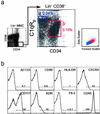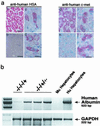C1qRp defines a new human stem cell population with hematopoietic and hepatic potential
- PMID: 12140365
- PMCID: PMC124933
- DOI: 10.1073/pnas.162104799
C1qRp defines a new human stem cell population with hematopoietic and hepatic potential
Abstract
The characterization of two distinct classes of hematopoietic stem cells based on CD34 expression and the ability of human bone marrow (BM) cells to differentiate into nonhematopoietic cells introduced new levels of complexity within the stem cell compartment. Here we report the identification and purification of a rare human stem cell population with hematopoietic and hepatic potential based on the expression of a receptor for the complement molecule C1q (C1qR(p)). We show that C1qR(p) is a positive marker of all BM-repopulating stem cells because it is expressed on both CD34(-) and CD34(+) stem cells from umbilical cord blood and adult BM. In addition, we show that highly purified lineage-negative CD45(+)CD38(-)CD34(+or-)C1qR(p)(+) cells not only have BM-repopulating capacity but also can differentiate into human hepatocytes in vivo. The identification of human hepatocytes in mouse livers indicates that the NOD/SCID (nonobese diabetic/severe combined immunodeficient) mouse model can be a valuable tool to study the differentiation potential of adult human stem cells. These findings may have important scientific and clinical implications in the field of human stem cell biology and transplantation.
Figures



References
-
- Osawa M., Hanada, K., Hamada, H. & Nakauchi, H. (1996) Science 273, 242-245. - PubMed
-
- Goodell M. A., Rosenzweig, M., Kim, H., Marks, D. F., DeMaria, M., Paradis, G., Grupp, S. A., Sieff, C. A., Mulligan, R. C. & Johnson, R. P. (1997) Nat. Med. 3, 1337-1345. - PubMed
-
- Jones R. J., Collector, M. I., Barber, J. P., Vala, M. S., Fackler, M. J., May, W. S., Griffin, C. A., Hawkins, A. L., Zehnbauer, B. A., Hilton, J., et al. (1996) Blood 88, 487-491. - PubMed
-
- Donnelly D. S., Zelterman, D., Sharkis, S. & Krause, D. S. (1999) Exp. Hematol. 27, 788-796. - PubMed
-
- Zanjani E. D., Almeida-Porada, G., Livingston, A. G., Flake, A. W. & Ogawa, M. (1998) Exp. Hematol. 26, 353-360. - PubMed
Publication types
MeSH terms
Substances
LinkOut - more resources
Full Text Sources
Other Literature Sources
Medical
Molecular Biology Databases
Research Materials
Miscellaneous

